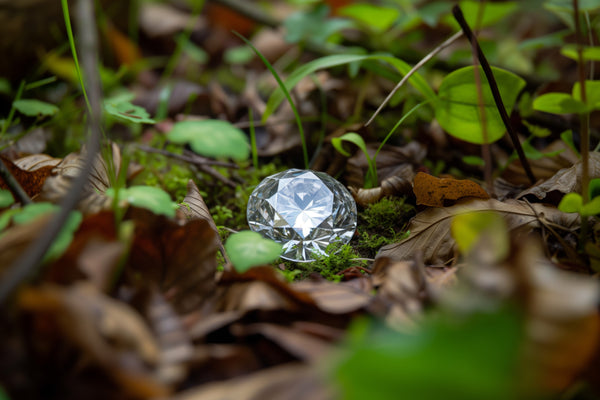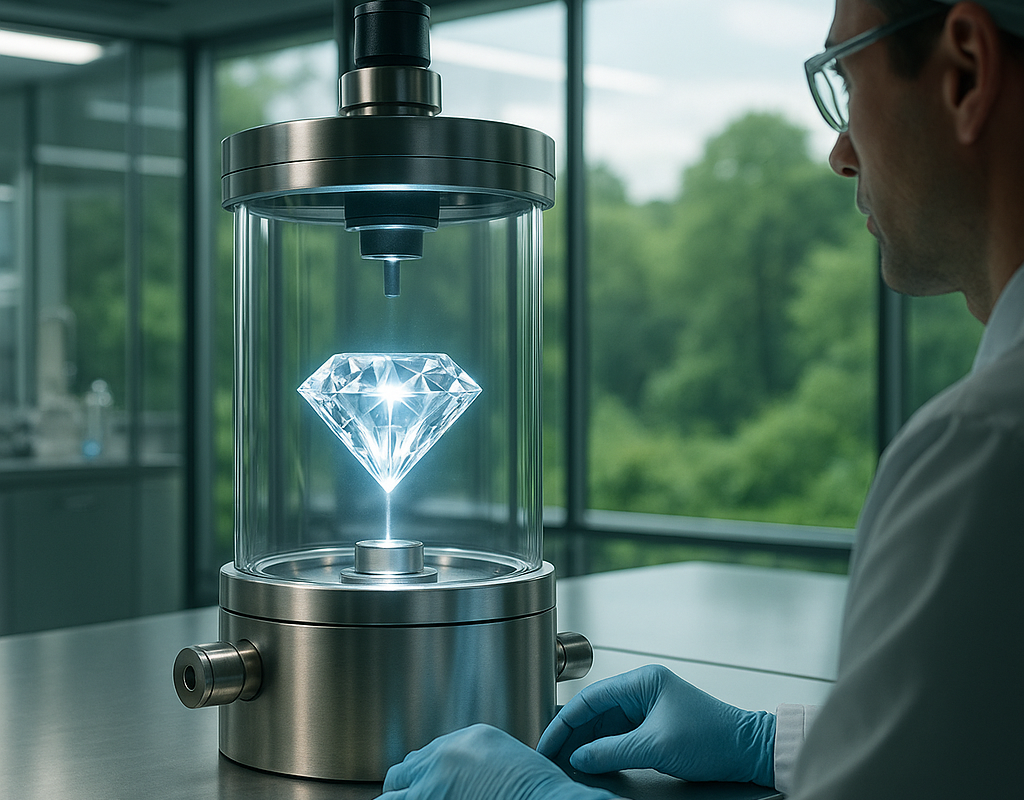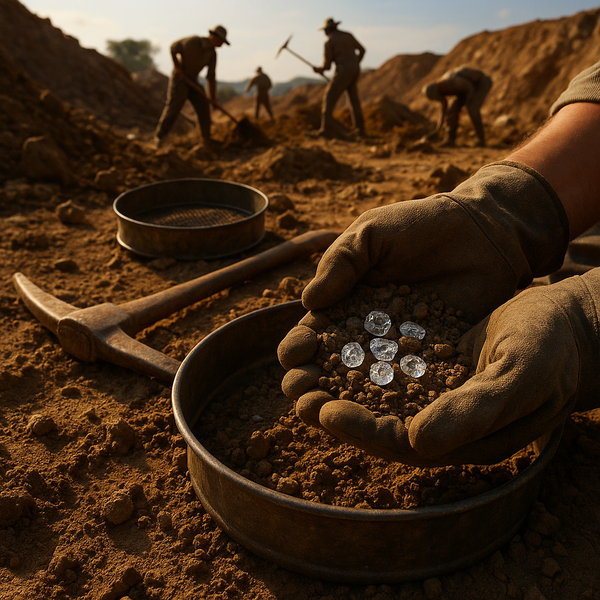The Sustainability Story Behind the Sparkle

As the world shifts toward more conscious consumption, the choices we make, even in something as personal as jewelry, are being guided by values. We now ask questions about origins, ethics, and environmental impact. And when it comes to diamonds, the impact of the natural diamond industry on the environment is huge. In this landscape, one question is leading the conversation: “Are Lab Grown Diamonds truly eco-friendly?” The answer is yes.
It’s time to look beyond the sparkle and consider the story behind our choices. To move past surface beauty and embrace a more conscious path, one that reflects not just light but lasting values. Because behind every diamond lies an impact, and understanding that is where true brilliance begins.
What Is A Lab Grown Diamond?

To truly appreciate Lab Grown Diamonds, it’s important to understand what exactly they’re replacing to achieve the “eco-friendly” tag. Lab Grown Diamonds, as the name suggests, are created in a lab. It is a common misconception that Lab Grown Diamonds are fake. Lab Grown Diamonds have the same chemical makeup and are just as real as Mined Diamonds. The only difference is that they are created in a Lab without mining and harming the environment.
Often known as man-made or cultured diamonds, Lab Grown Diamonds are created in a controlled environment and are made of pure carbon atoms arranged in a crystal structure. There are two major methods used to make lab grown diamonds - High Pressure High Temperature (HPHT) and Chemical Vapor Deposition (CVD).
High Pressure High Temperature (HPHT)
The HPHT method mimics the conditions of natural diamond formation in a lab. A small diamond seed is placed in carbon and is subjected to an extremely high pressure of 1.5 million PSI and a temperature of 1500°C. After several weeks, the carbon forms into a diamond nearly identical to those formed in the Earth. These can have a yellow or brown tinge or have impurities, just like mined diamonds.
Chemical Vapor Deposition (CVD)
The CVD method, the process used at Lucira, is a more modern approach to creating diamonds. A diamond seed is placed in a vacuum chamber filled with carbon-rich gas. The chamber is then heated to 800–1200°C, breaking down the gas into carbon atoms. These atoms slowly bond layer by layer to the seed, growing a diamond over several weeks. This process is more controlled and yields a largely colorless stone which can then be turned into high-quality diamonds of a variety of shapes and sizes.
How Are Mined Diamonds Formed Naturally?

Natural diamonds are formed deep within the Earth under conditions of intense heat and pressure. Under these conditions, carbon atoms bond in a crystal lattice structure, creating the unique hardness and brilliance for which diamonds are known. This process occurs over millions, sometimes billions, of years in the Earth’s mantle.
The diamonds do not stay buried forever. They are brought closer to the surface through rare volcanic eruptions. These eruptions carry the diamonds upward via magma that cools into rock types called kimberlite or lamproite. The resulting vertical formations are known as kimberlite pipes, which are the primary source of most mined diamonds today. Occasionally, diamonds also end up in riverbeds or coastal areas due to natural erosion and are discovered far from their original source.
Once a potential diamond deposit is identified through geological exploration, mining operations begin.
If the deposit is near the surface, open-pit mining is used, where layers of earth are gradually removed to access the ore. For deeper deposits, underground mining is employed, involving tunnels and shafts to reach the diamond-rich rock. In regions where diamonds have been carried away by rivers and streams, alluvial mining is common. This method involves extracting diamonds from sediment using techniques like panning or dredging. There is also marine mining, which uses specialized equipment to recover diamonds from the seabed off coastal regions.
After mining, the ore undergoes processing to separate the diamonds from other materials. This involves crushing the ore and using techniques such as dense media separation, which exploits the density difference between diamonds and other minerals. The extracted diamonds are then cleaned, sorted, and graded based on characteristics like size, color, and clarity.
The Environmental Cost of Mined Diamonds

While beautiful, mined diamonds cause an enormous amount of toll on the environment.
The process of extracting one single carat of diamond through a mining operation involves shifting more than 200 tons of soil and rocks. The mining process damages ecosystems while destroying forests and wiping out entire habitats. Not just that, the process also requires thousands of litres of water and emits a substantial amount of carbon dioxide due to the heavy machinery and fossil fuels involved in the process.
The production of diamonds generates hazardous waste materials. The chemical runoff created by mining operations continues to poison local rivers while simultaneously harming both human communities and wildlife populations. Although the diamond industry has implemented certain policy changes, it continues to inflict major environmental damage to ecosystems, which frequently becomes permanent.
The Rising Confidence in Lab Grown Diamonds
The production of lab grown diamonds takes place in controlled settings through state-of-the-art technology that duplicates the diamond formation process found in nature. Science has produced diamonds that match all criteria of natural diamonds yet require minimal environmental impact during their creation.
No Damage to Land
The creation of Lab Grown Diamonds occurs without any need to disturb the Earth's surface. These synthetic diamonds require no explosive materials or destruction of forests or natural ecosystems. The production process leaves neither permanent ground displacement nor extended environmental damage.
Significantly Less Water Usage
Water stands as a vital resource that traditional diamond mining processes use up in excessive quantities. The water requirements for Lab Grown Diamonds remain significantly lower at 80 percent compared to traditional diamonds.
Lower Carbon Emissions
The manufacturing of Lab Grown Diamonds through renewable energy creates a significantly reduced impact on the environment. Lucira employs the CVD (Chemical Vapor Deposition) approach for diamond manufacturing because it operates with higher energy efficiency. The industry maintains its transition towards green energy alternatives while certain labs continue to employ non-renewable sources.
Ethically Transparent
The production of Lab Grown Diamonds eliminates any possibility of conflict, along with forced labor situations. The production process occurs in defined spaces where workers receive fair treatment. Many ethical consumers value transparency about production methods as much as they value environmental protection.
A Clear Comparison

Let’s take a closer look at how Lab Grown Diamonds stack up against mined ones across key environmental factors.
Mining operations to extract diamonds lead to extensive land destruction that uses vast amounts of water and produces major greenhouse gas emissions. The production of Lab Grown Diamonds eliminates all environmental disadvantages. The manufacturing process of Lab Grown Diamonds occurs without damaging the environment while using minimal resources.
These conflict-free diamonds offer total transparency, which resonates with consumers prioritizing ethical sourcing.
Why Your Choice Matters
Choosing a Lab Grown Diamond is about more than just personal style, it’s a reflection of what matters to you. It represents a thoughtful approach to luxury, where beauty and responsibility go hand in hand. With Lab Grown Diamonds, you're embracing innovation, transparency, and a future-forward mindset, one that aligns with evolving values around sustainability and conscious living.
Lucira provides customers with exquisite jewelry beyond its aesthetic appeal. Our alternative diamonds provide a better and more compassionate choice than conventional diamonds while honoring love and protecting nature.
In Conclusion
Lab Grown Diamonds are every bit as real as they are responsible. Choosing one isn’t just about beauty; it’s a reflection of thoughtful living. They offer a more conscious way to embrace timeless luxury while not causing a toll on the environment.
So the next time you admire a diamond, let it be one that aligns with your values. Because with Lab Grown, you’re wearing a future shaped by purpose and beauty.




